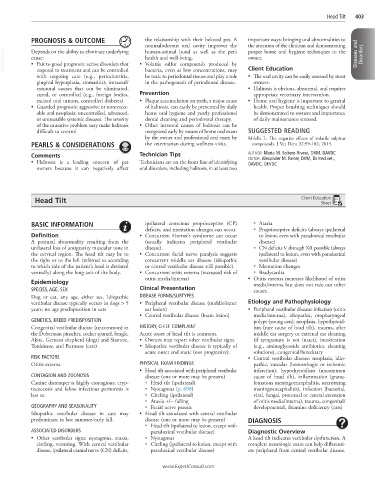Page 841 - Cote clinical veterinary advisor dogs and cats 4th
P. 841
Head Tilt 403
PROGNOSIS & OUTCOME the relationship with their beloved pet. A important ways: bringing oral abnormalities to
nonmalodorous oral cavity improves the the attention of the clinician and demonstrating
VetBooks.ir cause: • Volatile sulfur compounds produced by owner. Diseases and Disorders
human-animal bond as well as the pet’s
proper home oral hygiene techniques to the
Depends on the ability to eliminate underlying
health and well-being.
• Fair to good prognosis: active disorders that
Client Education
respond to treatment and can be controlled
with ongoing care (e.g., periodontitis, bacteria, even at low concentrations, may • The oral cavity can be easily assessed by most
be toxic to periodontal tissues and play a role
gingival hyperplasia, stomatitis); intraoral/ in the pathogenesis of periodontal disease. owners.
extraoral causes that can be eliminated, • Halitosis is obvious, abnormal, and requires
cured, or controlled (e.g., foreign bodies, Prevention appropriate veterinary intervention.
excised oral tumors, controlled diabetes) • Plaque accumulation on teeth, a major cause • Home oral hygiene is important to general
• Guarded prognosis: aggressive or nonresect- of halitosis, can easily be prevented by daily health. Proper brushing techniques should
able oral neoplasia; uncontrolled, advanced, home oral hygiene and yearly professional be demonstrated to owners and importance
or untreatable systemic diseases. The severity dental cleaning and periodontal therapy. of daily maintenance stressed.
of the causative problem may make halitosis • Other intraoral causes of halitosis can be
difficult to control recognized early by means of home oral exam SUGGESTED READING
by the owner and professional oral exam by Milella L: The negative effects of volatile sulphur
PEARLS & CONSIDERATIONS the veterinarian during wellness visits. compounds. J Vet Dent 32:99-102, 2015.
Comments Technician Tips AUTHOR: Maria M. Soltero-Rivera, DVM, DAVDC
• Halitosis is a leading concern of pet Technicians are on the front line of identifying EDITOR: Alexander M. Reiter, DVM, Dr.med.vet.,
DAVDC, DEVDC
owners because it can negatively affect oral disorders, including halitosis, in at least two
Head Tilt Client Education
Sheet
BASIC INFORMATION ipsilateral conscious proprioceptive (CP) ○ Ataxia
deficits, and mentation changes can occur. ○ Proprioceptive deficits (always ipsilateral
Definition • Concurrent Horner’s syndrome can occur to lesion, even with paradoxical vestibular
A postural abnormality resulting from the (usually indicates peripheral vestibular disease)
unilateral loss of antigravity muscular tone in disease). ○ CN deficits V through XII possible (always
the cervical region. The head tilt may be to • Concurrent facial nerve paralysis suggests ipsilateral to lesion, even with paradoxical
the right or to the left (referred to according concurrent middle ear disease (idiopathic vestibular disease)
to which side of the patient’s head is deviated or central vestibular disease still possible). ○ Mentation changes
ventrally) along the long axis of the body. • Concurrent otitis externa (increased risk of ○ Bradycardia
otitis media/interna) • Otitis externa increases likelihood of otitis
Epidemiology media/interna but does not rule out other
SPECIES, AGE, SEX Clinical Presentation causes.
Dog or cat, any age, either sex. Idiopathic DISEASE FORMS/SUBTYPES
vestibular disease typically occurs in dogs > 5 • Peripheral vestibular disease (middle/inner Etiology and Pathophysiology
years; no age predisposition in cats ear lesion) • Peripheral vestibular disease: infection (otitis
• Central vestibular disease (brain lesion) media/interna), idiopathic, otopharyngeal
GENETICS, BREED PREDISPOSITION polyps (young cats), neoplasia, hypothyroid-
Congenital vestibular disease (uncommon) in HISTORY, CHIEF COMPLAINT ism (rare cause of head tilt), trauma, after
the Doberman pinscher, cocker spaniel, beagle, Acute onset of head tilt is common. middle ear surgery or external ear cleaning
Akita, German shepherd (dogs) and Siamese, • Owners may report other vestibular signs. (if tympanum is not intact), intoxication
Tonkinese, and Burmese (cats) • Idiopathic vestibular disease is typically of (e.g., aminoglycoside antibiotics, cleaning
acute onset and static (not progressive). solutions), congenital/hereditary
RISK FACTORS • Central vestibular disease: neoplasia, idio-
Otitis externa PHYSICAL EXAM FINDINGS pathic, vascular (hemorrhagic or ischemic
• Head tilt associated with peripheral vestibular infarction), hypothyroidism (uncommon
CONTAGION AND ZOONOSIS disease (one or more may be present) cause of head tilt), inflammation (granu-
Canine distemper is highly contagious; cryp- ○ Head tilt (ipsilateral) lomatous meningoencephalitis, necrotizing
tococcosis and feline infectious peritonitis is ○ Nystagmus (p. 698) meningoencephalitis), infection (bacterial,
less so. ○ Circling (ipsilateral) viral, fungal, protozoal or central extension
○ Ataxia +/− falling of otitis media/interna), trauma, congenital/
GEOGRAPHY AND SEASONALITY ○ Facial nerve paresis developmental, thiamine deficiency (cats)
Idiopathic vestibular disease in cats may • Head tilt associated with central vestibular
predominate in late summer/early fall. disease (one or more may be present) DIAGNOSIS
○ Head tilt (ipsilateral to lesion, except with
ASSOCIATED DISORDERS paradoxical vestibular disease) Diagnostic Overview
• Other vestibular signs: nystagmus, ataxia, ○ Nystagmus A head tilt indicates vestibular dysfunction. A
circling, vomiting. With central vestibular ○ Circling (ipsilateral to lesion, except with complete neurologic exam can help differenti-
disease, ipsilateral cranial nerve (CN) deficits, paradoxical vestibular disease) ate peripheral from central vestibular disease.
www.ExpertConsult.com

